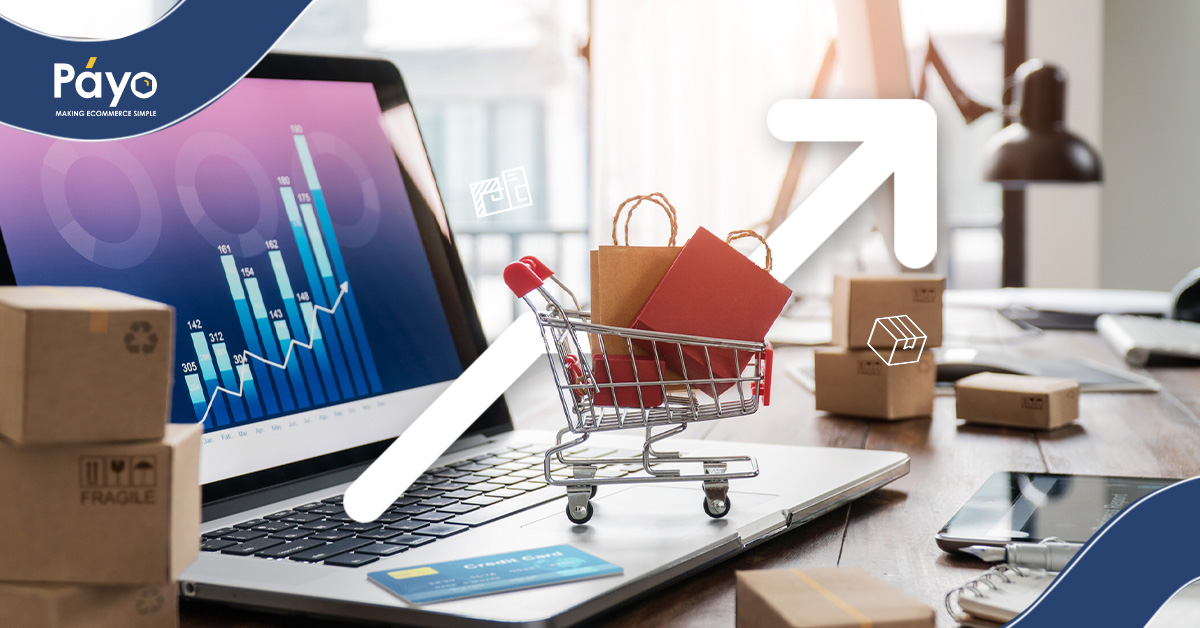

What is E-commerce, and how has it evolved?
E-commerce in the Philippines has been gaining momentum as more Filipinos dive into the digital marketplace. With just a few simple clicks or taps, they see the opportunities that E-commerce offers for both consumers and businesses.
But before anything else, what is E-commerce exactly? How did it start in the Philippines and how can merchants get into it?
Defining E-commerce
E-commerce is defined as the buying and selling of goods and services through an electronic network, which is mainly powered by the Internet. Simply put, it’s similar to how goods and services are sold in brick and mortar stores only this time, it’s online.
Nowadays, E-commerce in the Philippines is more visible and is rapidly integrated into people’s way of living. Anyone has access to it because of how widespread it has become. These include social media, online marketplaces, digital stores via websites, and so much more.
Thanks to technology, E-commerce unlocks many opportunities, from putting up small businesses to creating savings for consumers. It ultimately makes for a vibrant and thriving E-commerce ecosystem in the Philippines.
What Are the Types Of E-commerce?
Not all E-commerce businesses are the same. Here are the various types of E-commerce you should know about.
Business to Business (B2B)
This E-commerce type involves businesses selling products or services directly to other businesses. It is usually characterized by larger order volumes and longer sales cycles than other types of E-commerce.
Usually, items are sold in bulk at a discounted price to other businesses who then resell the products at a marked-up price.
Business-to-consumer (B2C)
This E-commerce type are businesses selling products or services directly to individual consumers. It is the most common type of E-commerce, with some of the most common examples being retail and online shopping.
Consumer-to-consumer (C2C)
This E-commerce type consists of individuals selling products or services directly to each other. Some notable examples are online marketplaces like Shopee, Lazada, Carousell, and Facebook Marketplace.
Consumer-to-business (C2B)
C2B refers to individuals selling their products or services directly to businesses. This type of E-commerce is gaining popularity with the rise of freelance work and the gig economy.
Business-to-administration (B2A)
This E-commerce type refers to businesses selling products or services directly to government bodies or agencies. It is often characterized by longer sales cycles and specific requirements for compliance and regulation.
It requires a thorough understanding of government regulations and procedures, as well as strong networking and relationship-building skills.
Consumer-to-administration (C2A)
This type of E-commerce includes individual consumers selling products or services directly to government bodies or agencies.
It is often associated with citizen services like filing taxes or applying for government permits.
Download: Payo’s Free E-commerce Checklist
Pros & Cons of E-commerce
To give you a better understanding of E-commerce and what it’s like to be in the industry, we’ve rounded up its pros and cons below.
Pros
It’s convenient
With E-commerce, consumers can easily shop for products or services from the comfort of their own homes. They don’t have to travel to physical stores or deal with long lines at checkout.
This convenience makes it easier for consumers to make purchases. Not only that, but it saves them time and energy.
It’s cost-effective for businesses
One major benefit of E-commerce for businesses is that it can be more cost-effective than traditional brick-and-mortar stores.
With E-commerce, businesses can save money on rent, utilities, and other expenses associated with a physical storefront. They may also be able to operate with fewer employees.
It offers global reach
With the internet, businesses can sell their products or services to customers all over the world, expanding their customer base and potentially increasing revenue.
It’s flexible
E-commerce allows businesses to be more flexible in their operations. They can easily change their product offerings, adjust pricing, and run promotions without having to make physical changes to a store.
This flexibility can help businesses stay competitive and adapt to changing market conditions.
It’s easier to show your products
Another advantage of E-commerce is that it allows businesses to showcase their products or services more visually and interactively than traditional brick-and-mortar stores.
With high-quality images, videos, and product descriptions, customers can get a better idea of what they’re buying, which can lead to increased sales.
You can give your audience a personalized experience
As an online store owner, you can personalize the shopping experience for your customers.
This means you can offer product recommendations based on their previous purchases or browsing history, send personalized emails with special offers, and even create a loyalty program to reward loyal customers.
This can lead to increased customer satisfaction and loyalty.
You can process a higher order of orders at the same time
With the power of technology and automation, you can process a higher volume of orders at the same time compared to traditional brick-and-mortar stores.
You can scale your business easily
Another advantage of E-commerce is that it allows businesses to scale up their operations easily. With a physical store, businesses may need to invest in a bigger space, hire more employees, and increase inventory to expand their operations.
But with E-commerce, businesses can simply add more products or services to their website, upgrade their website infrastructure, and increase their marketing efforts to reach more customers.
Cons
The customer’s brand experience may be weaker
One potential drawback of an online store is that the customer’s brand experience may be weaker compared to physical stores. In a physical store, customers can touch, feel, and try out products before making a purchase.
This creates a more memorable and satisfying experience. But with E-commerce, customers rely on product descriptions and images, which may not fully capture the product’s quality or functionality.
There is intense competition
With the ease of setting up an online store, the market can become saturated with similar products or services. This makes it more challenging for businesses to stand out and attract customers.
There’s limited in-person interaction
Another potential downside of E-commerce is the lack of in-person interaction with customers. While E-commerce can offer personalized experiences through technology, it may not fully replace the human connection that customers can experience in physical stores.
This can make it more challenging for businesses to build strong relationships with their customers and address their needs and concerns in real time.
You may face data security concerns
With online transactions, customers may be hesitant to share their personal and financial information, especially with the rise of cybercrime and data breaches.
Businesses need to take extra precautions to ensure the security of their customer’s data, such as implementing secure payment systems and regularly updating their website security measures.
There may be logistical challenges
Another potential challenge with E-commerce is the logistics of shipping and handling.
Businesses need to ensure that they have the necessary infrastructure and resources to handle a high volume of orders, including shipping and handling, inventory management, and order tracking.
E-Commerce Statistics in the Philippines
Take a look at some E-commerce statistics in the country. This will help you understand the current state of E-commerce in the Philippines and its growth potential.
1. In 2021, E-commerce sales in the Philippines reached $17 billion.
2. In March 2020, the number of online sellers was less than 2,000. By the end of the year, it reached 93,000.
3. By 2023, revenue in the E-commerce market is expected to reach $18.16 billion. By 2027, it is expected to reach $29.5 billion.
4. The number of users in the E-commerce market is expected to reach 60.41 million by 2027. In the same year, user penetration is expected to reach 48.6%.
5. The average revenue per user is expected to settle at $352.80.
6. The top E-commerce platforms in the Philippines are Shopee, Lazada, Zalora, and BeautyMNL.
7. The top product categories in the Philippines include beauty, electronics, household care, furniture, health, and fashion.
8. A foreign retail company may open a local office in the Philippines with $200,000 equity for 100% ownership.
9. In 2020, the Central Bank of the Philippines reported 20.1% digital payments from financial transactions worth $48.6 billion. This is a 61% increase from 2019.
10. According to DTI, E-commerce distribution to the country’s GDP is 3.4% in 2020. This year, it has increased to 5.5%. The government agency has also launched a roadmap to help eCommerce performance.
11. A lot of Filipinos still opt for cash payments as over 70% of Filipino adults remain unbanked. The Central Bank of the Philippines aims to bank around 70% of Filipinos by 2023.
12. Mobile wallet payments make up 30% of E-commerce payments in 2021.
13. English-speaking Filipino youth drive online media usage and E-commerce at a compounded annual growth rate of 27% and 58% from 2019 to 2020.
Ready to start of your E-commerce journey?
We hope this overview of today’s Philippine E-commerce landscape has been helpful for you. If you’re now thinking about putting up your own online store, that’s something that Payo can help you with!
Payo is a holistic E-commerce enabler in the Philippines that can help you with all your online selling needs. Whether you’re looking for a partner to help you with Warehousing and Fulfillment, or someone to give you Advanced Remittance and provide your customers with Live Customer Support, we’re the right choice.
Need more information about how you can tap into the Philippine market? Sign up with Payo today or send us a message at [email protected]. Let’s collaborate and find the best strategy for your business!

